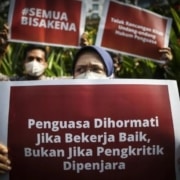
Penataran, the Majapahit state temple in Blitar, East Java, where famed king Hayam Wuruk was crowned. Photo: supplied
As diplomatic showdowns go, this summit had few parallels. In a grand pavilion in the magnificent grounds of the royal palace of Singasari in eastern Java, an envoy from Kublai Khan, the most powerful man in the world, sat down to pass on a blunt message to King Kertanegera, probably the most powerful ruler in Southeast Asia. The year was 1290, the mood was tense, and the chances of everything going horribly wrong were increasing by the minute.
Much was at stake. Kublai Khan ruled a vast empire that had spread as far as the eastern fringes of Europe. King Kertanegara had united the sprawling archipelago that today is known as Indonesia for the first time in history, and his power and influence was growing across Southeast Asia. Something had to give.
Meng Qi, the diplomat sent from the court of Kublai Khan in China, had been given clear instructions – King Kertanegara must agree to pay annual tribute and se nd a member of his royal family to live in the court of the Great Khan at his capital in Dadu (now Beijing).
The king flew into a rage. He wasn’t about to be lectured by some lowly messenger and had no intention of taking orders from Kublai Khan. Kertanegara feared nothing and no one. After all, he was a devotee of the dark art of magic and, in his mind, possessed supernatural powers. The king raised his voice for all to hear – Kublai Khan needed to be sent a strong message. On his signal, a guard took out a knife and cut off the unfortunate envoy’s nose.
This diplomatic disaster set in motion events that led, two years later, to an invasion by Mongol forces. When they arrived from China in 1293, King Kertanegara had already been assassinated and the city of Singasari had been burned to the ground. Instead, the Mongols got embroiled in a war with Kertanegara’s usurper. It all ended badly and the Mongols’ retreat from Java was both hasty and humiliating in equal measure.
The birth of Majapahit
It was in these tumultuous years that a new power centre, the city of Majapahit in eastern Java, emerged from the ruins of Singasari, ruled by Prince Widjaya, the nephew of King Kertanegara. At its peak – in the days of King Hayam Wuruk (1334-1389) and his feared vizir, Gajah Mada (1290-1364) – the Majapahit empire claimed to control a huge swather of territory, from modern day southern Thailand to Singapore, Java, Sumatra, Borneo, Bali, Lombok and beyond.

Penataran, the Majapahit state temple in Blitar, East Java, where famed king Hayam Wuruk was crowned. Photo: supplied.
Majapahit was a remarkably sophisticated society whose wealth and power were built on a combination of political cunning, huge rice harvests, and a navy so powerful that even the Portuguese, European mariners extraordinaire, were impressed.
It was also a place of great artistic achievement, religious diversity, and social tolerance. Kings worshipped Hindu and Buddhist divinities, and senior members of the priesthood were esteemed figures who held powerful positions at court, as did women. For context, in Europe, this was a time of religious crusades against Islam in the Middle East and constant strife between Catholics and Protestants.
Majapahit’s streets were crowded with Brahmins with matted hair, hermits in bark cloth, widows dressed all in white, and Chinese, Persian and Arab traders, among others. Bustling markets offered an astonishing range of goods from home and afar. Majapahit was a glorious medley of customs and beliefs, as indeed Indonesia is today, albeit to a lesser extent.
But some two hundred years after the empire rose to power, Majapahit fell into rapid decline. Its cities were abandoned, and its palaces and temples were reclaimed by the jungle.
Remnants of Majapahit today
Centuries later, Indonesia in 1945 was free of Dutch rule and in search of an identity. It had to look no further than Majapahit which the country’s first president, Soekarno, considered a precursor to modern Indonesia. Indeed, the colours of the Indonesian flag, red and white, are the same as those displayed on the banners borne by forces during the fall of Singasari in 1292.
There are signs that modern Indonesian is replicating some of the triumphs of the past. After a blood-soaked first encounter, the Majapahit empire found a way to come to an accommodation with the mighty emperors who ruled China. A few years later there were regular diplomatic exchanges. The same applies today, with Jakarta navigating a careful diplomatic path to match its own interests with those of Beijing.
Less visible elements of ancient heritage are also discernible. The Majapahit court was a place of political intrigue where power was perpetually in flux. Influential women pulled strings and ruled behind the scenes, and distinctive dress codes made it easy to tell different social groups apart. Some of this, too, is preserved in Indonesia today. Like in the days of Majapahit, modern Indonesia delicately balances vastly different people, interests and regions across the archipelago.
Attitudes to the legacy are as diverse as the dynasty itself. To many, the empire represents a glorious past when Majapahit commanded respect across the region. In this narrative, Gajah Mada, the legendary vizir, is a hero of national identity. To others, such as Acehnese and Sulawesian separatist figures, he was nothing but a Javanese aggressor in search of loot and imperial glory at any cost. These resentments are still challenges for modern Indonesian governments based in Java.
For all of Majapahit’s strengths and weaknesses – every empire has them, after all – there can be no doubt that its rise and fall remains a story worthy of a broader audience. It is one of intrigue, murder, secrets, suspense, revenge and war in a land filled with beautiful temples and imposing palaces. It remains the most powerful empire in Asia that most people have never heard of.
Perhaps the same can be said of societies as it can be for people. However much they may change, much of their essential character is set during their formative years. In Indonesia, and large parts of Southeast Asia, that was the glorious civilisation that spawned the Majapahit empire.
This blog is based on excerpts from “Majapahit; Intrigue, betrayal and war in Indonesia’s greatest empire” (Monsoon Books, 2024). Herald Van Der Linde also published Jakarta: History of a Misunderstood City (Marshall Cavendish, 2020).
Bibliography
Berg, C.C, Kertanegara, de Miskende Empire-Builder. Orientatie, July 1950.
Dramer, Kim. Kublai Khan. New York: Chelsea House, 1990.
Pigeaud, Theodore G. Th and Prapañca. Java in the 14th Century: A Study in Cultural History : The Nāgara-Kěrtāgama by Rakawi Prapañca of Majapahit, 1365 A.D. Vol. I–IV. The Hague: Martinus Nijhoff, 1960
Jackson, Peter. Genghis Khan to Tamerlane. New Haven: Yale University Press, 2024
Groeneveldt, Willem Pieter. Notes on the Malay Archipelago and Malacca Compiled from Chinese Sources. Batavia, Den Haag: W.Bruining, M. Nijhof, 1880.
Manguin, Pierre-Yves. ‘The Southeast Asian Ship: An Historical Approach.’ Journal of Southeast Asian Studies 11, no. 2 (1980): 266–76.
Prapanca, and S. O. Robson. Deśawarṇana: Nāgarakṛtāgama. Verhandelingen van Het Koninklijk Instituut Voor Taal-, Land- En Volkenkunde 169. Leiden: KITLV, 1995.
Rockhill, W.W. ‘Notes on the Relations and Trade of China with the Eastern Archipelago and the Coast of the Indian Ocean During the Fourteenth Century.’ T’oung Pao 15, 1914.
See Hung, Hsiao-chun, Hartatik, Tisna Arif Ma’rifat, and Truman Simanjuntak. ‘Mongol Fleet on the Way to Java: First Archaeological Remains from the Karimata Strait in Indonesia.’ Archaeological Research in Asia 29 (March 1, 2022): 100327.










 https://www.flickr.com/photos/130075348@N08/51219074247/
https://www.flickr.com/photos/130075348@N08/51219074247/